Learning how to pasteurize straw is necessary if you want to start growing certain types of mushrooms on your own. Although it may seem daunting at first, this article will take you through the ins and outs of straw pasteurization.
Cereal straws (not hay) such as oat or wheat are used as a base, or substrate, upon which mycelium grows. Mycelium is a thread-like collection of cells that represent the vegetative growth of a fungus. Much like you need an apple tree to produce apples, you need healthy mycelia to produce mushrooms.
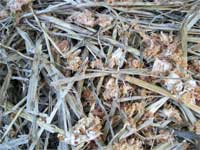
So how does one prepare straw? There are a variety of different methods, with hot water being the most common. There are other ways as well, such as using cold, steam, or certain chemicals.
Let’s go over straw pasteurization for growing mushrooms in greater detail. We’ll start with the theory behind it and explain why we use pasteurization instead of sterilization. Next, we’ll look at a few different methods. If in the end this all seems like too much work, we’ll review some other alternatives.
To Pasteurize or To Sterilize? That Is the Question…..
When learning how to grow mushrooms, you may come across the term ‘sterilization’. Yet for substrates such as straw and dung, you want to pasteurize them, not sterilize.
To pasteurize means to reduce the amount of harmful competing organisms. When the process is over, there is still some micro-activity going on in the substrate, usually in the form of beneficial bacteria.
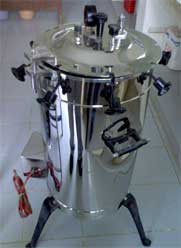 To sterilize means to remove all living organisms in a substrate. When you’re done, there should be nothing left alive. This process is usually done with chemicals or very high heat and pressure, such as with the autoclave on the right.
To sterilize means to remove all living organisms in a substrate. When you’re done, there should be nothing left alive. This process is usually done with chemicals or very high heat and pressure, such as with the autoclave on the right.
Sterilizing simply leaves the straw too susceptible to contaminants. Without the beneficial bacteria to guard against foreign competitors, the substrate becomes a free for all for anything to grow.
Having beneficial microorganisms leftover allows you to inoculate the straw without using special sterile procedures. Thus you can do it outside in the open air without a flow hood or fancy equipment.
Think of it like having a house sitter when you’re away. Sterilizing is like leaving the doors unlocked with no one home. Pasteurizing is like leaving a friend at your house. Someone may still break-in, but it’s less likely.
Straw Pasteurization Methods
Now let’s take a look at some different ways to pasteurize straw in order to grow mushrooms.
Before using any of these techniques, you should first cut your straw into 1 to 3-inch segments. Use a lawnmower, blender, or any other machine that will do the job. Note that if you do it by hand, your fingers will be really sore if you have a lot of straw!
Don’t skip this step. Mycelium will colonize smaller pieces of straw much faster and easier. It will also make the whole thing much easier to work with.
Water Bath
Pasteurization occurs between 160 and 180 degrees Fahrenheit. Anything more than that and you risk killing good bacteria and allowing the bad to bloom.
With a water bath, you pasteurize by soaking the straw in 160-degree water for an hour. You can do whatever you want to accomplish this, but here are common methods for larger and smaller amounts of straw:
Smaller Scale:
- Fill a large pot half way with water. Bring to a boil, and then back the heat off by about 1/3. Check the temperature with a meat thermometer.
- Keep adjusting the heat and checking the temperature until it stays within a stable 160 – 170 range. This may take some time and fiddling.
- Put your straw into a nylon mesh bag. You can get one online or in most stores, usually near the laundry supplies. Only use as much straw as can be submerged in the water.
- Put the straw bag in the pot with something heavy on it so the whole thing is covered in water. Let the whole thing sit for an hour, keeping an eye on the water level and temperature.
- After an hour, remove the bag and put it in a strainer. Be careful as the water and straw will be very hot. You may want to wear rubber gloves.
- Allow the bag to drain and cool to room temperature. Use immediately.
Larger Scale:
- This is the same basic principle, only with a larger pot and heat source. Start by filling a clean, food-grade container, such as a 55 gallon metal drum, half full with water.
- Heat the water in the barrel until it stays constant at around 160 degrees Fahrenheit. Use a long thermometer to measure the temperature. The heat source can be a gas burner or something else, just make sure it’s safe.
- Put the straw in a laundry or wire mesh basket. Submerge it in the hot water for one hour, keeping an eye on the water level and temperature.
- After an hour, remove the straw and lay it on a clean table or plastic tarp to cool and drain. Make sure the straw has cooled to below 100 degrees and use immediately.
Note that the large-scale water bath merits some caution. You’ll be working with a lot of hot water and a heat source. Make sure everything is safe, secure, and sturdy.
Also, keep in mind that wet straw is very heavy. Depending on the amount you use, lifting it out of the barrel may be a two-person job. You may want to tie your bag to a long branch so it’s easier to lift out of the water.
Cold Incubation
Mycologist Paul Stamets developed the idea of cold incubation. While not pasteurization per se, it is a way to manipulate straw to give mycelium an advantage. This works on the idea that the mycelium of some cold-loving mushrooms will colonize at a low temperature. This lower temperature slows down the microscopic competitors.
You must use mushrooms that fruit in lower temperatures for this to work, no heat lovers here!
Soak some straw in a bucket of water for one hour. Afterward let it drain so it’s moist, not soggy.
Mix the straw and spawn thoroughly in a box, bag, plastic tub, or whatever. Be sure to use lots of spawn.
Cover the top with a plastic bag and let it colonize outdoors in temperatures between 35 – 50 degrees Fahrenheit. When the straw is fully colonized with white mycelium, bring it up to fruiting temperatures.
I have used this method before with success. It isn’t as successful as straw prepared with a heat bath, but it is less work!
Hydrogen Peroxide Method
Hydrogen peroxide will kill competitor spores and foreign microbes, but won’t hurt mycelium. Treating your straw with hydrogen peroxide will give it the mycelium a head start.
Soak your straw in water for one hour. Drain, rinse it thoroughly with water, and then drain again.
- Allow the straw to soak for a day in a bath of water and hydrogen peroxide. Use 1 liter of hydrogen peroxide to 1 gallon of water.
- Rinse and drain the straw a few times after it’s done. Add spawn and incubate as you normally would.
This method is far less effective than a hot water pasteurization bath. However, it is far less work and much cheaper.
Other Methods
Here are a few other ways to pasteurize straw for growing mushrooms. I have not tried these, so I have no comment as to their effectiveness:
- Steam heat – Heat the straw to the correct temperatures with steam. Requires steam-injection equipment.
- Pasteurize with dry heat – Put your straw in a room/closet/container that can be heated to the correct temperature with dry heat.
- Other chemicals – Some people treat straw with bleach or other chemicals. I’ve never tried this, and have never been wild about the idea.
- Oven – Place straw in an oven bag usually used for cooking turkey. Pre-heat your oven to 170 degrees and set the bag inside it on a tray or baking sheet. Let it cook for one hour, making sure the bag does not touch the sides of the oven!
Okay, so I’ve done the oven method and yes, it does work. However, it also makes your kitchen smell like baking straw and the inside of your oven nasty. Best for those who never use their oven and consider it as an oversized kitchen ornament!
Alternatives to Preparing Straw
Are the above methods too much work? Does the idea of babysitting a water bath of straw make you yawn?
If you don’t want to pasteurize straw you can still grow mushrooms. Here are some ways around it:
Use a different substrate – straw is just one way of growing mushrooms. You may find using logs or wood chips more gratifying. See this page on substrates for more information.
- Buy a mushroom grow kit – If you just want to grow a few mushrooms without a lot of hassle and preparation, a mushroom growing kit is for you. These convenient blocks of sterilized and enriched sawdust require little maintenance beyond some water and patience.
- Buy it – It may sound like cheating, but you can buy bags of pasteurized straw over the Internet. They’re more expensive, but you’ll save time and effort. A good option if you’re just starting out or only want to do a few mushroom experiments. Definitely not cost-effective for the large-scale grower.
Whatever method you use, pasteurized straw makes for a great mushroom substrate. With the right attitude, it’s an easy and fun part of growing mushrooms.
Go ahead and try to pasteurize some straw. If it turns out to be too much work, use one of the alternative methods. Keep growing!

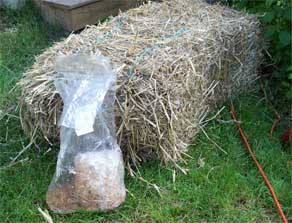
 Soak your straw in water for one hour. Drain, rinse it thoroughly with water, and then drain again.
Soak your straw in water for one hour. Drain, rinse it thoroughly with water, and then drain again.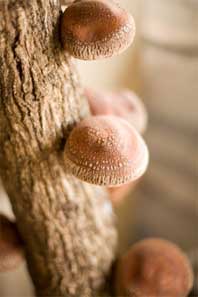 Use a different substrate – straw is just one way of growing mushrooms. You may find using logs or wood chips more gratifying.
Use a different substrate – straw is just one way of growing mushrooms. You may find using logs or wood chips more gratifying. 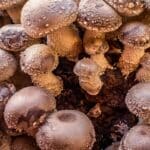
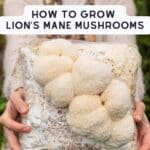
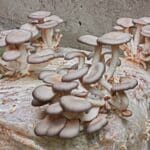
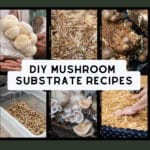
James Fox says
Thank you for all this info. I am a novice with some success and loads of questions. Have 3 books and over course Google and Reddit are the best. My question is: Would you soak the straw prior to placing in an oven bag or put it in the bag dry and the soak after pasteurization? Thank you!
Jenny says
Yes, you definitely want to soak the straw prior to putting it in the oven bag. The substrate should be moist but not soggy. You may need to squeeze excess water out before bagging. Happy growing!
Helen Collins says
I tried growing morels which I know is the hardest one to try the first time. everything was great they colonized but when I put them in the substrate, they turned greenish looking and then we’re invaded by bugs. What did I do wrong?
Jenny says
Oh my, I have no idea. With morels, it could be a dozen things that we don’t even know. There is no “sure-fire” way to grow them, it’s very hit or miss for the most part. This is a good starter https://www.mushroom-appreciation.com/growing-morels.html